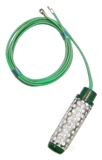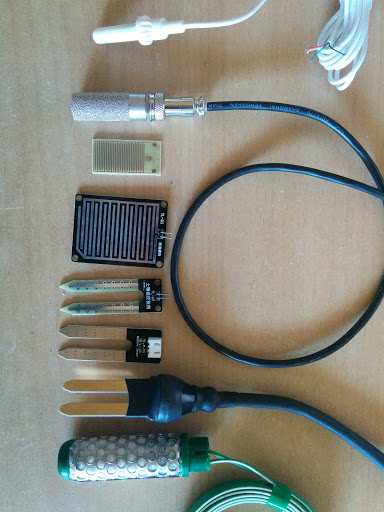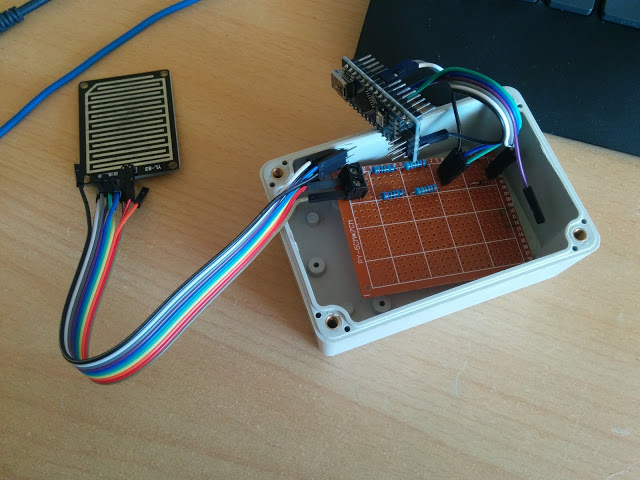Soil Humidity and temperature sensor - Watermark / Davis granular matrix sensor
-
Another try to see if I can find one that can be immerged in the soil.
Now the expensive version of the Watermark Soil Moisture Sensor (granular matrix sensor).

WATERMARK 200SS Features:In use since 1978, the patented WATERMARK sensor is a solid-state electrical resistance sensing device that is used to measure soil water tension. As the tension changes with water content the resistance changes as well. That resistance can be measured using the WATERMARK Sensor. The sensor consists of a pair of highly corrosion resistant electrodes that are imbedded within a granular matrix. A current is applied to the WATERMARK to obtain a resistance value. The WATERMARK Meter or Monitor correlates the resistance to centibars (cb) or kilopascals (kPa) of soil water tension. The WATERMARK is designed to be a permanent sensor, placed in the soil to be monitored and “read” as often as necessary with a portable or stationary device. Internally installed gypsum provides some buffering for the effect of salinity levels normally found in irrigated agricultural crops and landscapes. 0-200 Centibar range Stainless steel enclosure Fully solid state Will not dissolve in soil Not affected by freezing temperatures Internal compensation for commonly found salinity levels Inexpensive Easy to use No maintenancebut that is the commercial part, the real hard thing is here:
Arduino.CC duiscussion"we have to read from it with AC voltage, cos if we apply DC voltage we could damage the sensor. So 555 timer based circuitry is needed. [...] HobbyBoards sells a 555 timer based circuit to measure from the leaf moisture sensor. "emsystems, has developed circuit, that measures resistance between two connectors using AC current, to avoid oxidation of the sensor and outputs frequency. This circuit is quite generic, for example, you can connect potentiometer, and see how frequency output is changing when you adjust pot. "http://www.emesystems.com/lwet_dat.htm
http://www.emesystems.com/lwet/documents/LWET_manual.pdfhttp://www.emesystems.com/smx/documents/SMX_short.pdf
"The SMX converts this AC resistance to frequency, voltage, and current that can be read by data-loggers."To sum it up, an AC resistance mesure is needed to have it working for a longer time... has anyone the experience on how to do this ?
-
Another try to see if I can find one that can be immerged in the soil.
Now the expensive version of the Watermark Soil Moisture Sensor (granular matrix sensor).

WATERMARK 200SS Features:In use since 1978, the patented WATERMARK sensor is a solid-state electrical resistance sensing device that is used to measure soil water tension. As the tension changes with water content the resistance changes as well. That resistance can be measured using the WATERMARK Sensor. The sensor consists of a pair of highly corrosion resistant electrodes that are imbedded within a granular matrix. A current is applied to the WATERMARK to obtain a resistance value. The WATERMARK Meter or Monitor correlates the resistance to centibars (cb) or kilopascals (kPa) of soil water tension. The WATERMARK is designed to be a permanent sensor, placed in the soil to be monitored and “read” as often as necessary with a portable or stationary device. Internally installed gypsum provides some buffering for the effect of salinity levels normally found in irrigated agricultural crops and landscapes. 0-200 Centibar range Stainless steel enclosure Fully solid state Will not dissolve in soil Not affected by freezing temperatures Internal compensation for commonly found salinity levels Inexpensive Easy to use No maintenancebut that is the commercial part, the real hard thing is here:
Arduino.CC duiscussion"we have to read from it with AC voltage, cos if we apply DC voltage we could damage the sensor. So 555 timer based circuitry is needed. [...] HobbyBoards sells a 555 timer based circuit to measure from the leaf moisture sensor. "emsystems, has developed circuit, that measures resistance between two connectors using AC current, to avoid oxidation of the sensor and outputs frequency. This circuit is quite generic, for example, you can connect potentiometer, and see how frequency output is changing when you adjust pot. "http://www.emesystems.com/lwet_dat.htm
http://www.emesystems.com/lwet/documents/LWET_manual.pdfhttp://www.emesystems.com/smx/documents/SMX_short.pdf
"The SMX converts this AC resistance to frequency, voltage, and current that can be read by data-loggers."To sum it up, an AC resistance mesure is needed to have it working for a longer time... has anyone the experience on how to do this ?
Two ways of doing it:
1 - With capacitors:
http://forum.arduino.cc/index.php/topic,22250.0.html2- By alternating the voltage way:
http://vanderleevineyard.com/1/category/vinduino/1.html
The resistance has to be moved to 4700ohms.
The formula from the datasheet is known:
http://www.kimberly.uidaho.edu/water/swm/Calibration_Watermark2.htm -
soil humidity/temp sensors :

My first vinduino like with 4.7k Ohm and zenners.

Remark: the wetness sensor is here as an example, I will not use this one. I anyway use the possibility to have reverse voltage to avoid elecrtolitic deterioration.
-
discussion follow up: http://forum.mysensors.org/topic/990/soil-tensiometer-sensor-network/28
